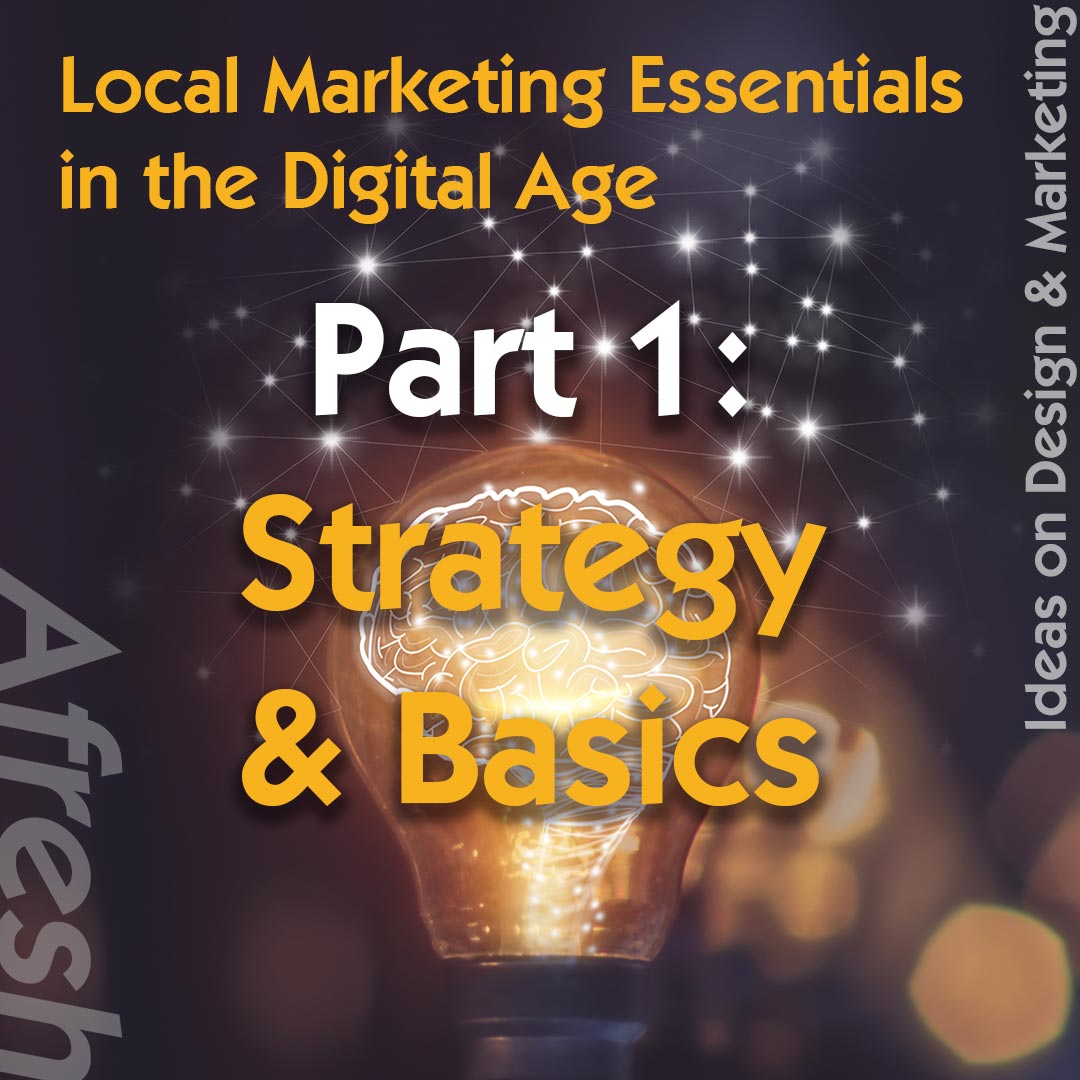afresh: Local Marketing Essentials in the Digital Age – Part 1: Strategy and Basics

Part 1: Strategy and Basics
The past two years have been especially challenging for local small businesses. On the positive side, tough times force many business owners to rethink how they do things and consider how they might approach the local market in creative new ways.
In this article, we’ll outline questions to ask yourself as you strategize your new marketing plan. And, we’ll give you some basic, must-have items to get you started. No matter what your industry, if you are operating in a local market with a focus on local customers, consider this an essential go-to-market strategy checklist. In Part 2, we’ll dig into specific tactics and channels, and build your marketing plan.
Outline & Quick Links:
Strategy
Consider these key questions as you begin your marketing plan. Get ready to jot down your notes as you go along.
Understand Your Market and Customer
- Whom do you serve? In other words, who is your clientele? Be specific in describing their demographics and psychographics.
- What is your customer’s mindset?
- What kind of news and content do they consume, and where and how do they consume it?
The answers to these questions will lead you to the channels where you can effectively reach your customer base. For instance, in general, if your customers tend to be older, you may reach them more effectively with traditional methods such as ads in local newspapers or radio spots, whereas digital channels appeal more to younger customers.
Define Your Offering: It’s More Than You Think
- What is the need or want that your business fulfills?
- What emotions do you want your customers to feel when they interact with your business?
- What kind of experience do you provide?
- Where might customers look externally to satisfy the need or want that you offer when it arises in their life?
- When are they in a state of mind that is receptive to what you have to offer?

For example, let’s say your offering is yoga classes. Your classes fulfill multiple needs: providing customers a physical place to stretch out, giving them educational instruction on how to correctly do the poses, offering them inspiration and encouragement, and giving them an opportunity to connect with others in community. The emotions you want your customers to feel are relief, relaxation, joy, inspiration, and maybe excitement. The kind of experience you provide is unique to your niche. Let’s say you specialize in innovative offerings that push the envelope and can’t be found anywhere else. Customers might start out by asking their friends where they do yoga or by searching online for “Santa Cruz yoga classes.” Potential customers can be more receptive to your offering by hearing about you in a certain context, for example at a health fair. In summary, it’s important to understand exactly what it is you are selling, beyond the obvious, which in this example is “classes.” When you look at the big picture, your offering is much more than that.
Plan Your Long Term Goals and Mission
- What are your business goals and overall mission?
- Do you want to grow your business or maintain its current size?

By defining where you ideally want to be near-term and long-term, you can work backwards from where you are and determine what needs to happen as you take steps toward your goal. Let’s say you are a builder, and most of your business is in residential renovations. You have a few subcontractors that you call in on a project basis. But you want to grow. You want to take on bigger projects, hire full-time employees, and establish yourself in the commercial construction market. Alternatively, you may not want to grow. Maybe you want to cut back to only smaller projects that you can handle alone. But, in order to maintain your current income level, you need to go upmarket and work on higher-end projects. These are different goals that start from the same place. The strategy depends on the goals.
Determine Your Communication Style and Messaging
- What kind of messaging resonates with your customers?
- How would your customers describe your products and services?
- What are the key ways you are different from the competition? In other words, what is your unique value proposition?
- What content do you have available to work with to communicate your unique value proposition visually?
- What content do you need to gather or develop to fill in the gaps?

Imagine you own a print shop. Your customers are looking for detailed and specific information on the types and sizes of materials you can produce, and they want to know about your level of customer service and attention to their needs. Your messaging should be to the point, well organized, and very clear.

In contrast, if you run a music venue, your messaging would be different. Although you also have some details to present about events, overall, your messaging will be more about conveying a vibe. What makes your venue unique is its atmosphere. Your aim is to create a mood.
A print shop, on the other hand, is unique in other ways and distinguishes itself with content that speaks to those ways. Perhaps, the print shop’s unique value is its location, fast turnaround service, or product offerings.
The messaging you craft should communicate the unique aspects of your business to customers. The best way to convey this is with professional and original content. However, professional photographers and writers can be costly. To save money, you could use stock footage, or you could take the photos and videos yourself in house. Even if they’re not perfect, they could get your message across better than any stock image.
Bolster Your Reputation
In places with a small-town atmosphere, reputation goes a long way toward driving revenue. Even in today’s digital age, people still like to do business with people they know and like. A strong reputation can take years to build.
How do you build your reputation as a new business or as an existing business in need of a reputation boost or repositioning? Reputation is basically word of mouth. And word of mouth happens naturally when you deliver on your promises to customers. So don’t over-promise. Instead, over-deliver. Ask yourself how you can delight your customers and get them to sing your praises to others. It’s okay to incentivize referrals and do so without being tacky.
Ask yourself:
- What can you offer your happy customers to encourage them to share their experience with you?
- Is there some kind of customer loyalty program you can create?
- With whom do you want to be associated in the community?
- Are there events that you can sponsor along with other businesses to get your name out there?

In most localities, there are professional networking groups, chambers of commerce, and local expositions or tradeshows that carry clout and provide opportunities for businesses to market themselves. If these don’t exist in your area, maybe you could start one. These are very effective ways to market certain kinds of businesses and should not be overlooked! Service businesses in particular will benefit from this approach.
For consumer-oriented businesses, many localities have retail associations that produce business directories for tourists, such as downtown associations. In some towns, businesses join together to host festivities on Friday nights. Do you have business owner friends? Maybe you could put some marketing material at their locations and offer to do the same for them at your location? If your “location” is a website, you could share links to each other’s sites. There are many ways to join with other businesses to support each other in the community.
Check Off the Basics
While you are mulling over your grand strategy, here are some basic to-do items you need to check off your list while you prepare to take your marketing to the next level.
Note: It’s important to separate your business accounts from your personal accounts in the online world. This will protect your business reputation while giving you the freedom to express yourself in your personal accounts.
Quick To-Do List:
- Update your Google listing (Search and Maps).
- Update your Bing! listing. (Sync your Bing! listing to your Google account to make this easier next time.)
- Claim and/or update your free business listing on Yelp.com.
- Verify that your Apple Maps location exists and is accurate.
- Create a business page on Facebook with your current information.
- Create an Instagram account for your business.
- Create a Twitter account for your business.
- Create business accounts for any other relevant social media platforms (YouTube, Pinterest, LinkedIn, and others).
When creating these accounts, it’s very important to use a consistent business email for each and every account that you manage as the administrator. The worst thing you can do is to let employees or contractors set up these business pages for you under their own personal accounts. There are so many things that could go wrong, so please learn from the mistakes of others and set up the accounts yourself the right way from the start!
Some of these things can be tricky. Macdonald Design LLC is here to help you set up and make sure all of this is done right. Give us a call (+1-831-462-2383), chat (down to the right) or email to schedule a Basics Tune-Up.
Make Time to Strategize
Yes, it’s a lot to think about, so let’s break it down. Your first task is simply to read through this article. Sit on it for a week. Then set aside a couple of hours next week for a “marketing strategy session,” and put it on your calendar. It doesn’t have to take a lot of time. You just have to schedule it.
When addressing these questions, write the answers down by hand rather than typing. This can open the pathways to creativity, and you may find that the answers flow more easily. Ask a close confidant to join you in a brainstorming session at your favorite café or restaurant, and make it fun!
Macdonald Design LLC can be that third party that helps you brainstorm ideas for your marketing strategy. Give us a call (+1-831-462-2383), chat (down to the right) or email to schedule a Marketing Strategy Brainstorm Session.
In the next article (Part 2: Your Marketing Plan) we’ll cover how to turn your answers into your marketing plan.
